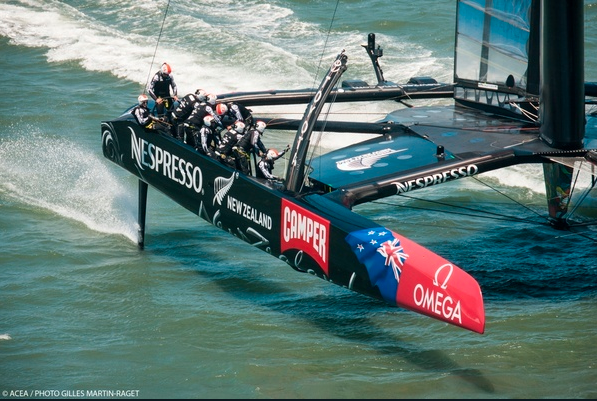Second point for Emirates Team New Zealand, but against a second no show
For the second time this week Emirates Team New Zealand scorched around the two laps of the windward/leeward course alone to score a point in Round Robin 1 Since the news that Artemis would not be ready for racing before early August, it was of course no surprise that race two was another one-sided affair. The greater surprise was perhaps that the Kiwis had to complete the full course in order to get the point. And even then the points will count for little as the winner of the Round Robin phase gets to go straight to the LV final. With only two boats in the game at this stage, both would go anyway.
But there is nothing quite like training on the course for real and while the last two days may look rather bizarre, they remain valuable training days for the team. Their guest programme is said to cater for around 100 people a day, is another reason why Dalton’s team will be out there too, which is good news for the rest of us as we get to see a bit more of what makes this team tick.
So what did we learn today about ETNZ?
1) They completed the 16.16-nautical-mile course in 45 minutes, 28 seconds (about one minute quicker than Sunday’s race) and achieved a top speed of 43.26 knots, 49.7 mph. The wind was slightly stronger, peaking at 20 knots as opposed to 16 knots on Sunday.
2) They are refining their gybes by the day to the point where foil to foil gybes are becoming the norm. This is of crucial importance and here there is simply no substitute for hours on the water. According to the crews I spoke to in San Francisco, if the boat comes off its foil in gybe its speed could drop from the mid to high 30s to 14-15 knots, a halving of boat speed. Get it right through the gybe and the boat speed should stay in the high 20s. Today in the 11 gybes that ETNZ performed on the race course, most were good foil to foil gybes, one was spectacular with the speed never dropping below 30 knots. The gains here over a boat that stumbles around the corners will be huge.
3) Typical upwind speeds were 20knots in a breeze that topped out at 20 knots true. Downwind the typical speeds were 35-38 knots.
4) Using the full width of the course, (why wouldn’t you when you have no opponent to cover), sees seven tacks upwind and four gybes downwind.
5) Forget gennakers. Even though there was no incentive to fly a gennaker downwind as there was no competition to beat, with the kinds of speeds these boats are clocking up downhill, gennakers will not be used. In fact, Luna Rossa have already removed their bowsprit.
6) Refining the aerodynamics package is now part of the next phase of development. Take a look at the deck plate and how the wing now has an additional section slid in underneath to seal the wing against the deck. This end plate effect stops high pressure from leaking to the low pressure side and makes the wing more efficient as well as stopping a draggy vortex from developing.
7) For all the refinement and practice, even the best can still look wobbly. On the second downwind leg, (the first full length one), Barker wrestled to keep the boat up on its foils as she hobby horsed downwind. What the teams won’t tell you, but regular observers will is how close these boats still get to a major spill. This was a hint of just that.
The jury heard evidence today (Tuesday) in the protest from the Kiwis and Italians against race management over the safety recommendations issue. We are hearing that a decision is expected on Wednesday.
In the meantime, the next scheduled race is Thursday, Luna Rossa v Artemis, the latter can’t show up and the former may choose not to if the dispute is not resolved.
Sadly, if neither show up, it could still be possible for the event to step one more rung down the ladder before things improve.




